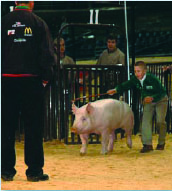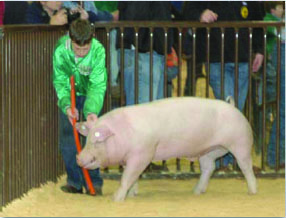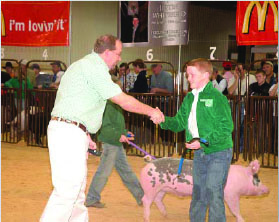Swine Showmanship
Showmanship is an exhibitor’s ability to most effectively present an animal in a competitive show ring environment. Showmanship is the one area of livestock showing over which the exhibitor has the most control. In showmanship, you are judged on your abilities to control and present your hog in the show ring and holding pen, and answer questions about your project. You should try to drive your hog so that its phenotypic strengths are seen more than its weaknesses. Advanced planning, practice, and hard work are keys to becoming a good showman. Swine showmanship not only generates enthusiasm in the show ring, but also teaches many valuable lessons that can be used in day-to-day life. These lessons include responsibility, learning about work ethic, determination to reach a goal, winning graciously, and accepting setbacks with dignity. Winning takes practice at home and can become a reality by working with the hog and preparing it for show.
Show Ring Success Begins at Home
Successful showmen start early. As soon as you purchase an animal, it is important that your animal starts to build trust with you. This is less stressful for you and your hog, and will ensure that your animal is ready for the show. Spend time with your animal to get it comfortable and used to you. A good way to do this is during feeding. Just sit or stand in the pen while your animal eats. Remember that this process takes patience and time.
Here are some helpful hints to assist the initial gentling and “show breaking” process:
- Start working with your animal early.
- Give time to your animal by staying in the pen with them and getting them familiar with your voice.
- Try to handle your pig. You may want to try this for the first time while your pig is eating. This will build trust between you and your pig.
- Playing a radio will allow the hog to get use to noises and human voices and also help calm the animal.
- The first few times you drive a hog, drive them to a place they want to go such as to feed or water. Voice rewards are very important, and will allow the animal to become more comfortable with you.
- Use a small pen to prevent the hog from escaping the handler. Gradually move to larger pens as your hog becomes gentle and more controllable.
- Practice makes perfect. Introduce your animal to the driving tool and hand brush well in advance of your show. Your animal needs to be trained how to walk on command in the direction requested. Occasionally, have another person present while you train your animal, so they can act like the judge would at a show.
There are a few items you will need when showing your hog. A driving tool, small hand brush and a small rag are pieces of equipment you will need in the show ring and holding pen.
In some extremely hot environments, it is considered okay to carry a water bottle into the ring as you show your pig. However, in most cases, carrying a water bottle would be an unnecessary distraction. Show management will either provide water bottles at the pens or consider it standard for friends or family to bring one to you when you are penned to help you clean or cool your pig as needed.
The driving tool is needed to guide or drive your hog (Figure 1). Do not overuse the driving tool. Allow the hog to walk naturally. Transition the driving tool between both hands as needed and use the tool on the pig’s side or jowl when the pig stops or should turn directions. Some swine showmen use their dominant hand to hold the driving tool regardless of which side of the pig they are on, while others switch hands as they switch sides. Both methods are acceptable as long as switching hands is done smoothly. Never hit, kick, or beat, but merely tap on the hog. Be careful to never use the driving tool on the pig’s ham or loin. Examples of acceptable driving tools include:
- Livestock cane
- Hog whip
- Riding crop
- Hog driving stick
- Plastic piping
Hog whips with “flappers” on the end are not recommended because they are noisy and unprofessional.
A small hand brush and rag are essential while showing a pig. Pigs will rub against one another and get dirty or the judge may sprinkle your hog with shavings. As a showman, it is your responsibility to keep your animal clean with your brush or rag. They can be placed in your less dominant hand or in your back pocket. Placing the brush and rag in your back pocket is the preferred method because it frees up your hand, allowing you to use your hand to further guide your hog (Figure 2). Like the driving tool, never place your hand on the pig’s ham or loin.
Especially during summer shows, make sure your hog remains well hydrated, which will allow it to remain more comfortable and help prevent overheating and stress problems.

Figure 1. As soon as you enter the show ring, the driving tool is there to assist you in directing your hog.

Figure 2. Naturally move your hog around the ring with its head up. Finding open areas will help get your pig noticed.
Driving Your Hog
There is no halter used when showing a hog. Instead, exhibitors must drive their hog with complete confident control for the judge to appraise the animal.
When driving, you should be on the hog’s side which is opposite the judge. For example, if the judge is on the hog’s right side, you should be driving from the left side of your hog, always keeping the animal between you and the judge. Try not to “over show” your animal. A judge will not be impressed if you always block everyone else’s view or over maneuver your animal. Furthermore, your animal will become irritable. Instead, keep your pig 10 to 20 feet away from the judge, but never under the judge’s feet.
The driving tool should be used without drawing attention to your hog or to the tool being used. Touch the animal from the fore rib forward (shoulder and jowl area) to turn. If you want the hog to move to the right, touch the left jowl of the hog (Figure 3). If the hog needs to move to the left, touch the right side. Using your hands to help maneuver your hog is a very acceptable and encouraged showmanship technique especially to drive your hog out of the corner of the show ring. Always remain calm and simply place your hands in front of the hog’s face to assist in turning it away from the corner (Figure 4).
By the time you arrive at the show, your hog should already be trained to drive and act correctly. Observe where you are going in the show ring and look to see that you are driving your pig in the open areas with adequate distance from the other hogs. Walk at a moderate pace and straight ahead with the hog’s head up in the air (Figure 2). During the drive, the hog’s head should be just high enough to present an impressive style, attractive side view and graceful walk. Working on keeping the head up should not be carried to extremes that can be distracting or that keep your hog from moving out at a good pace. Let your hog walk out freely and naturally, not too fast and not too slow, never turning the pig sharply. Good showmen are constantly looking for openings in the ring to drive their hog, keeping their pigs off the fence, away from groups of pigs and out of corners.
Be observant for signals and instructions from the judge and the ring officials. Often, a judge will ask you to pen your pig. Naturally walk your pig to the assigned area as quickly and efficiently as possible. Open the gate when you have driven your pig close to the pen, pen your pig, then close and latch the gate behind you. While in the pen, keep showing.
The proper technique while in the pen is as follows: First, address the cleanliness and well being of your pig by brushing them off and wetting the haircoat. Spray bottles should be available at the pens or brought to you by someone, so you can clean and cool your pig. Second, stand or kneel behind your pig, keeping your eye on the judge for instructions to re-enter the ring. The pig should be at a side view in the front of the pen by the gate, with its head at the end where the gate will open. This position allows the judge to see your pig as he looks at the pen, and your pig is pointed in the direction needed for an easy exit. When the judge signals for you to leave the pen, open the gate and shut the latch behind you.
While the judge is appraising your animal, he or she could walk around your animal. It is important you are aware the judge is coming. If the judge comes from the right side of your animal around the front of the animal’s head, walk behind the animal to reach the right side as the judge comes even with the head of the animal. This allows the judge to see more of your animal and lets them know you are aware of their location. Move the opposite way if the judge comes from the opposite direction. Keep the animal between you and the judge at all times. One of the key points in swine showmanship is to never obstruct the judge’s view.
Special Situation
Fighting hogs: Occurs when a group of hogs engage in a fight. DO NOT jump between fighting hogs. You may use a cane to assist in controlling the situation. A ringman will use a board to further separate fighting animals. Remember that keeping yourself and other exhibitors safe is the number one priority.
Special Term
Driving a hog: Occurs when an exhibitor moves the hog with a driving tool and hand brush in the show ring to allow the judge to fully see the appearance of the animal. When driving a hog, there are three views that should be shown—the rear view, side view, and front view.

Figure 3. Keep your hog between you and the judge at all times. Tell your hog which direction to turn by use of the driving tool.

Figure 4. Use your driving tool along with your hands to help get your pig out of the ring corner.
Appearance
The animal should be clean, well-groomed, and clipped in those areas as acceptable or recognized for the breed or sex. The hair should be clipped to proper lengths. A good grooming job exemplifies pride of ownership by the exhibitor. The many hours spent preparing your animal in advance of the show will be evident in the show ring.
You should be neat and clean just as the hog should be well-groomed. Remember, the audience looks at you too. Fancy clothes are not necessary, but neatness and cleanliness are important. It is recommended that you wear appropriate clothing consisting of a tucked-in sleeved shirt, leather boots, jeans, and a belt. Avoid faded blue jeans and T-shirts. Instead, a more professional look is better. Check the show regulations concerning dress code and always comply with the requirements such as wearing a specific shirt or jacket. In most cases, it is never appropriate to wear a cap or hat.
Practice good posture in showmanship because it is proper and will keep your hog more calm. Stand with your back straight (Figure 2). Never lean back, but leaning forward is acceptable. Leaning slightly forward expresses a positive interest of concern, as if you were getting into a good action movie and were leaning forward. Keep your feet relatively close together as you walk with natural steps.
The idea is for your pig to get noticed, not you. Keep eye contact with the judge to ensure you follow the directions given.
Always be aware of the judge’s location; however, do not concentrate on the judge so much that you forget about your animal and the animals around you. Your first obligation is to your hog, so keep checking to see that it is clean and walking in the correct area and position. Be ready to move if the judge signals, or answer any questions about your hog, such as age, breeding program, retail cuts, harvesting information, breed type, or feeding program.
Special Term
Good Sportsmanship: Occurs when opponents, show team members, officials, staff, and audience are treated with respect by livestock exhibitors. Good sportsmanship is practicing etiquette at all times within the show ring. The real winners are those who know how to persevere and to behave with dignity—whether they win or lose.
Show Time!
When you arrive at the show, check the show ring for low spots or dark areas. This will help you avoid these areas when driving your hog, both improving the appearance of your animal and impressing the showmanship judge.
Be sure to know the show schedule and be ready when the class is called. A late arrival in the show ring may cause some confusion or distract the judge. It is wise to confirm your hog is entered in the correct class. Animals entered in the wrong class cause confusion and slow down the show. If the show requires each exhibitor to have an entry card before entering the ring, make sure you have the card, and any other required record or identification. Observe the judging of a few classes prior to showing to familiarize yourself with ring procedures at each show and the judge’s preferred show style.
The first thing to do when entering the make-up ring is to look for the ring official who is directing the class. The ring official is there to help organize the class and minimize distractions for the judge. Be alert at all times, and carry out the instructions of the judge and ring officials closely.
Your first obligation is your own safety and the second is the presentation of your animal. However, your third priority is to assist others when you can. For example, if an animal gets into a fight beside your hog, first, help ensure that the other exhibitors are safe. Ringmen will be there to help clear the fight. Drive hogs away from the fight. This will keep the show moving properly and the judge will recognize that you care about the success of others and not just yourself.
Most of the time when the judge gets on the microphone, there may be two or three hogs left to place, therefore, he has not made his final placing decision. Continue to work hard and display good sportsmanship. Leave the ring in an orderly manner as instructed by the ring steward, and pick up your award. When the judge has given his final placing, the class is over, but your job is not.
Have Fun and Do Your Best!
Always be courteous to show officials, the judge, and other exhibitors (Figure 5). Good sportsmanship is an important part of showmanship; therefore, you will win graciously and accept setbacks with dignity. Show your appreciation for the sponsorship of the show by writing thank you notes. Be a good representative of your club, school, county, and family. Work hard, practice, always try to do better next time, and profit from your mistakes as you gain experience. Above all have fun!

Figure 5. Showing hogs is a very rewarding experience. Show appreciation to those who have helped you succeed.
Rusty Gosz
Extension Youth Livestock Specialist
Cassie Bacon
Animal Science Student Intern
